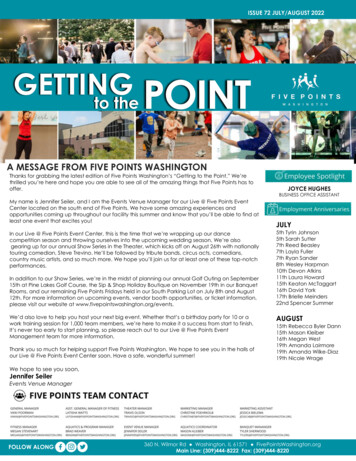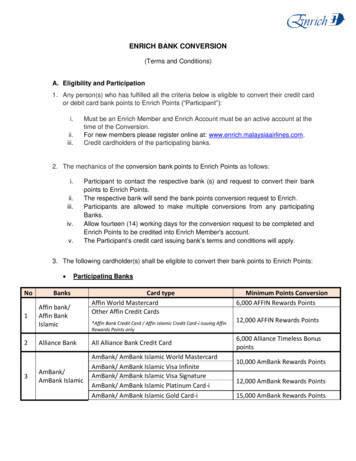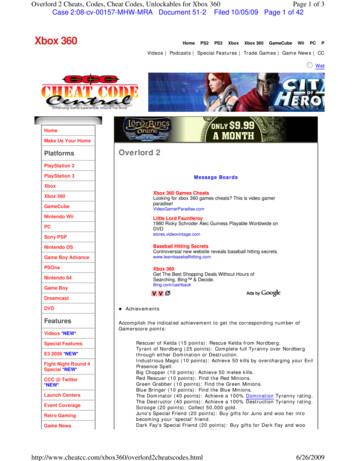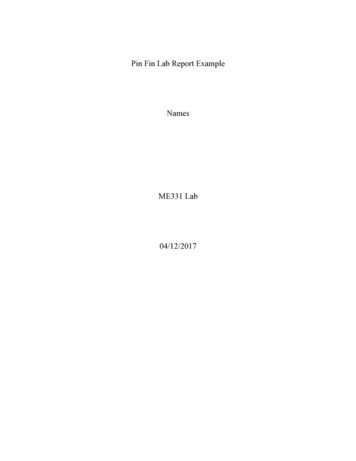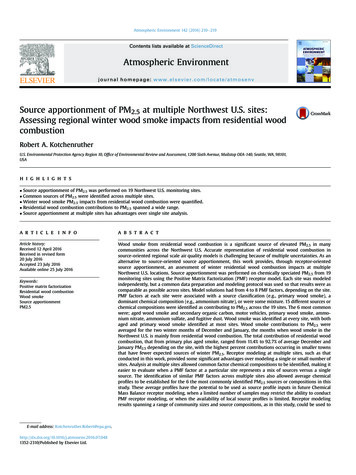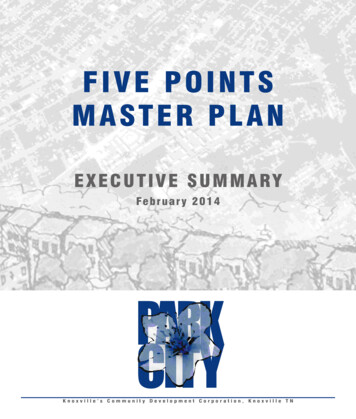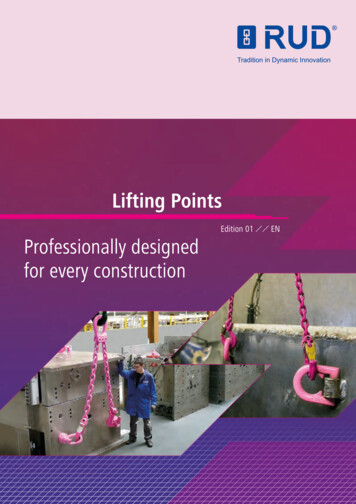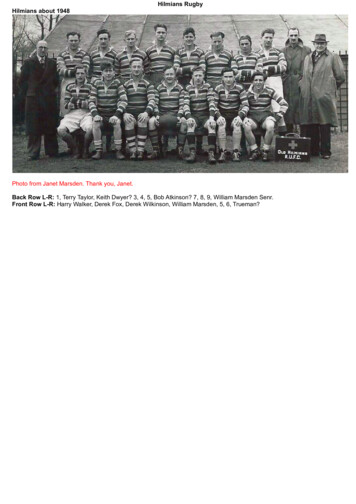
Transcription
Differing Perspectives on Five Points: Insider vs. OutsiderPage 1 of 5Relevant Unit ObjectivesModule 3: Building New YorkThis lesson addresses the following Essential Questions: How did free African Americans contribute to the building of New York?How did the unique social and economic fabric of New York contribute to the building of African Americansocial and economic institutions?Objectives of the LessonAimThrough examining several primary and secondary historical sources, students will understand opposing viewpointsconcerning the Five Points region of NYC in the 19th century.At the conclusion of this lesson, students will be able to: Explain how and why the Five Points neighborhood was seen as a different place to people living inside theneighborhood and those living inside the neighborhood, especially African Americans.Explain how the unique nature of the Five Points neighborhood allowed for building free African Americansocial and economic institutions.IntroductionStudents respond to the following question as a warm-up activity:Have you ever been part of a group that seemed good but was seen in the opposite way by someone outside thegroup? Why did this seem good to you? What did you fail to see?Why did the outsider feel the way they did? What did they fail to see?Did these different views cause conflict? If so, describe?Who was “right” in this situation? Why?
Differing Perspectives on Five Points: Insider vs. OutsiderPage 2 of 5Instructional ProceduresStep One:The teacher leads students in a brief discussion about “insider” and “outsider” status and the perspectives attached tothose positions. Key points to address might be: What makes someone an insider? An outsider?Do outsiders have a right to comment on the actions of insiders? If so, under what circumstances?Can outsiders ever truly understand the experience of insiders?Step Two: Introducing Five PointsThe teacher provides background about the Five Points neighborhood utilizing the information below (also providedas Handout One). This can be completed as a whole class reading. During the reading, the teacher can clarifyvocabulary and concepts and answer student questions.Five Points was a neighborhood around the intersection of Worth Street, Baxter Street, and Cross Street, which nolonger exists. It became a world-famous slum in the 1840s. In colonial times, however, it was a quiet place north ofthe city that included a pond, marshes, and a hill that overlooked it all. Africans buried their dead near the pond andlived nearby in a large area called “Land of the Blacks.”By the early 1800s, however, the city was growing and housing was needed. The hill was removed and its earth,along with garbage, dumped into the pond. Homes and businesses were built on this landfill, but the ground was softand damp; the houses soon began to rot and topple, and the unpaved streets turned to mud. As the housing decayed,New York’s first slum was born. Poor Irish and German immigrants moved in to live alongside the AfricanAmericans there.The neighborhood became famous for crime and disease. But, more happily, it was also known for dance.Competitions between Irish and black musicians and dancers helped to invent a brand new dance form called tapdance.Five Points was also where many abolitionist organizations were located. There was the Chatham Chapel, whereblack and white abolitionists met, and the African American Mutual Relief Hall. Churches such St. Philip’s AfricanEpiscopal Church and the African Bethlehem Church were part of the Underground Railroad, as were many of thehomes in the area. Five Points was a dangerous neighborhood, but it was also a safe haven for those fleeing slavery.Step Three: Discovering the Many Sides of Five Points – WebQuestUsing the websites listed below, (teachers can also print materials from these sources) students will complete theDiffering Perspectives on Five Points Graphic Organizer (Handout 2). In this simple activity, students will searchfor both positive and negative information about the Five Points and the historical groups or persons who had theseopinions. This activity will be conducted in teams of three or four. Once completed, one member from each groupwill pair with a member from one other group. Then, the original group will reconvene to share all of theirinformation.1. Description of Five Points Historyhttp://urbanography.com/5 points/2. The Five Points Archaeological Dighttp://r2.gsa.gov/fivept/
Differing Perspectives on Five Points: Insider vs. OutsiderPage 3 of 53. The New York City Abolitionist Riot, YandSlavery/Chapter%20E/Documents/1834D.ABO.pdf4. New York City Draft Riots and Five 17749.html5. Black History Remembered – University of Washingtonhttp://www.blackpast.org/?q Step 4: Discussion of WebQuestTeachers lead a class discussion about their research findings from the WebQuest. Key questions to resolve will be: In what ways was Five Points positive and for whom? Who articulated these positions? In what ways was Five Points negative and for whom? Who articulated these positions? Is there a relationship between these positions and insider/outsider status? In what ways did the history of Five Points illustrate free Africans having the opportunity to contribute to thebuilding of New York on their own terms?Conclusion (Optional)1.Students write a dialogue to be acted out as a role play between 19th century insiders and outsiders to the FivePoints community. One participant(s) will argue for all that is positive about Five Points; another participant(s)will argue for all that is negative about Five Points. The dialogue will take the form of a conversational debateabout the merits of Five Points to its inhabitants (insiders) and other NYC residents (outsiders). After studentshave developed the script for the role play, they perform it in class.2.In high school classes, the teacher might show portions of Martin Scorsese’s film “Gangs of New York,” set inthe Five Points region. For commentary on the historical accuracy of the film, teachers should see “Historicalfiction to historical fact: Gangs of New York and the whitewashing of history,” Social Education, May/June2003. Vol. 67(4), p. 213MaterialsHandout 1: Background information on Five PointsHandout 2: Differing Perspectives on Five Points Graphic OrganizerWebsites:#1: Description of the Five Pointshttp://urbanography.com/5 points/#2: The Five Points Archaeological Dighttp://r2.gsa.gov/fivept/#3: The New York City Abolitionist Riot, YandSlavery/Chapter%20E/Documents/1834D.ABO.pdf#4: New York City Draft Riots and Five 17749.html#5: Black History Remembered – University of Washingtonhttp://www.blackpast.org/?q aah/five-points-district-new-york-city-1830s-1860s
Differing Perspectives on Five Points: Insider vs. OutsiderHandout One: Historical Background on Five PointsFive Points was a neighborhood around the intersection of Worth Street, Baxter Street, and Cross Street,which no longer exists. It became a world-famous slum in the 1840s. In colonial times, however, it was aquiet place north of the city that included a pond, marshes, and a hill that overlooked it all. Africansburied their dead near the pond and lived nearby in a large area called “Land of the Blacks.”By the early 1800s, however, the city was growing and housing was needed. The hill was removed andits earth, along with garbage, dumped into the pond. Homes and businesses were built on this landfill, butthe ground was soft and damp; the houses soon began to rot and topple, and the unpaved streets turned tomud. As the housing decayed, New York’s first slum was born. Poor Irish and German immigrantsmoved in to live alongside the African Americans there.The neighborhood became famous for crime and disease. But, more happily, it was also known fordance. Competitions between Irish and black musicians and dancers helped to invent a brand new danceform called tap dance.Five Points was also where many abolitionist organizations were located. There was the ChathamChapel, where black and white abolitionists met, and the African American Mutual Relief Hall. Churchessuch St. Philip’s African Episcopal Church and the African Bethlehem Church were part of theUnderground Railroad, as were many of the homes in the area. Five Points was a dangerousneighborhood, but it was also a safe haven for those fleeing slavery.Page 4 of 5
Differing Perspectives on Five Points: Insider vs. OutsiderPage 5 of 5Handout Two: Differing Perspectives on Five Points Graphic OrganizerDescription ofFive PointsPositive or Negative?Why?What historical groupwould hold thisperspective?
Five Points was a dangerous neighborhood, but it was also a safe haven for those fleeing slavery. Step Three: Discovering the Many Sides of Five Points - WebQuest Using the websites listed below, (teachers can also print materials from these sources) students will complete the Differing Perspectives on Five Points Graphic Organizer (Handout 2).

